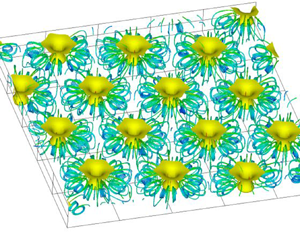Article contents
Pattern wavelengths and transport characteristics in three-dimensional bioconvection generated by chemotactic bacteria
Published online by Cambridge University Press: 22 November 2022
Abstract

We conducted a three-dimensional numerical simulation of bioconvection generated by oxygen-reactive chemotactic bacteria. This study investigated the bioconvection patterns, interference between plumes, and the wavelength of bioconvection patterns. In addition, we clarified the transport characteristics of cells and oxygen in the bioconvection. Multiple plumes occur in the suspension, and three-dimensional bioconvection is formed around the plumes by the cells with vortex rings arising around the plumes. Even if bioconvection at a high Rayleigh number is disturbed, the bioconvection is strongly stable with respect to disturbances, and the pattern does not change due to disturbances. Bioconvection changes depending on the physical properties of bacteria and oxygen, and in particular, the rate of oxygen consumption by bacteria significantly affects the strength of bioconvection. Bioconvection patterns with different plume arrangements and shapes are formed for different Rayleigh numbers or initial disturbances of the cell concentration. As a result, the wavelengths of the patterns also vary. As the Rayleigh number increases, interference between plumes is strengthened by the shortening of the pattern wavelength, so the velocities of both upward and downward flows increase. Many cells are located under the plumes, and a strong shear flow occurs in these regions. As the pattern wavelength decreases, the cells are affected by high shear stress. Then the convective transport of the entire suspension strengthens and the transport characteristics of cells and oxygen improve. When the chamber boundary is changed to side walls, bacteria adhere to the wall surface, and plumes are arranged regularly along the side walls.
Information
- Type
- JFM Papers
- Information
- Copyright
- © The Author(s), 2022. Published by Cambridge University Press
References
- 4
- Cited by


